Quick poll (in chat)… Who’s Using Custom Properties?
a.k.a. CSS Variables
- ✅ all the time
- 🤔 on occasion
- ❌ not at all
Variables Store Values
- Variables are common in programming
- Capture, store, and access values
Global… Design Tokens
brand colors, sizes, fonts, etc…
- In CSS that has often meant
- Global ‘design tokens’
- brand colors, sizes, fonts, etc
Local… Design Tokens
button-background, primary-grid…
- Don’t have to be global
- Don’t have to be simple
Re-use to Avoid Repetition
- Broadly any CSS value we want to re-use
Provide Meaningful Names
hsl(331deg 42% 30%)
color-mix(in oklab, darkRed 73.29%, mediumBlue)- What is this color?
- A mix of darkRed and mediumBlue?
- With variables we can give it
- A meaningful name, based on…
‘deep-raspberry’
- What it looks like
- (deep raspberry)
‘best-color’
- Why we chose it
- (the best color)
‘action’
- What it signifies
- (action, maybe)
‘link-text’
‘button-background’
- Where we’ll use it
- (link text and button backgrounds?)
--deep-raspberry: hsl(322, 92%, 24%);
--best-color: var(--deep-raspberry);
--action: var(--best-color);
--link-text: var(--action);
--button-background: var(--action);- Or all of the above?
- We can use one variable to name the next
- Creating different layers of meaning

- Like audio patch bays
- Connecting an input to an output
- With a physical cable
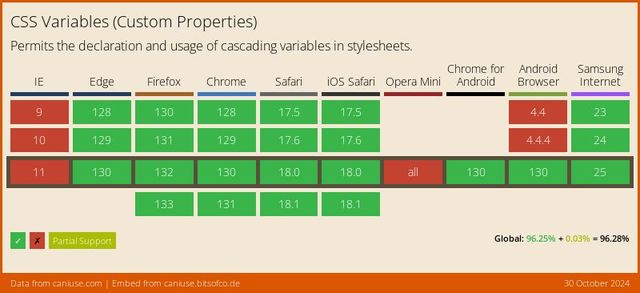
- Widely supported since 2016…
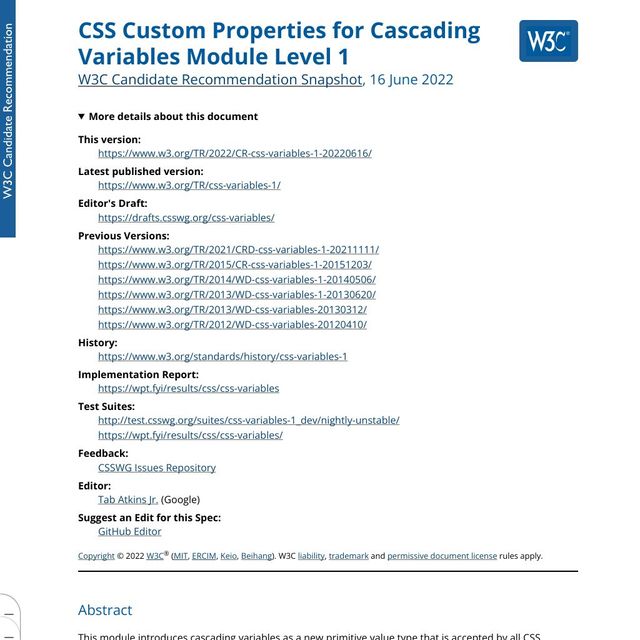
- Two names
- These are Custom Properties, that we define
- Which can be used as Cascading Variables
- That’s in some ways a strange combination
- And means they don’t work the same as variables in most languages
- Instead, they act…
Properties Of Elements
(in the cascade)
- Like any other property in CSS
- They are directly attached to elements,
--name: value;
- We can declare a value in CSS
- Using a normal declaration syntax,
- (property and value)
- But we come up with the property name
- And it has to start with a double-dash
Called
--dashed-idents
For mixing custom & built-in identifiers
<dashed-ident>s are <custom-ident>s, but not vice versa- This is called a ‘dashed ident’ in CSS
- Not only used for custom props
- But anywhere a ‘custom identifier’
- (something we name as authors)
- Might share space with built-in CSS keywords
built-in-property: value;
--custom-property: value;- In this case, sharing space with built-in properties
- Need to tell the difference
- Avoid conflicts in the future
-webkit-property
-moz-property
-ms-property
--property
webkitmozms-<empty>-property- The syntax comes from browser prefixes
- Which have (mostly) been phased out
- Remove the browser name, and now it’s ours
.warning {
--state-color: maroon;
}- We can attach that declaration to elements
- And it will go through the whole process of cascading and defaulting
- On each element, the same as a built-in property
- Except that it won’t do anything…
.alert {
border: medium solid var(--state-color);
}- Until we apply it to an actual built-in property…
- That’s the whole point!
- We get to decide where and when to use these values
var( --property )
- Which we access from the
varfunction - Var, parenthesis, the name of the custom property

- Like the audio signal in these cables,
- We don’t hear any sound
- Until we plug that signal into a speaker of some kind
- An amplifier,
- Something that turns signal into noise
button {
background-color: var(--button-background);
}- In CSS
- Normal properties are the amplifier

- Turning silent ‘tokens’ into rendered styles
By default No Initial Values
- But since these are ‘custom’ properties
- They don’t have any initial value
- Except the ‘guaranteed invalid value’ which we’ll discuss
By default Variables Inherit
- And since we’re not usually defining them on every element
- We’re often going to rely on inheritance
html { /* or :root */
--all-my: variables;
--defined: on the;
--root: element;
}- It’s very popular to define some or all custom properties
- In one place, on the root element
- And expect them to inherit everywhere.
- So let’s look at inheritance!
Cascading Removes Extra Values
result: 0-1 cascaded values
- Once the cascade is done filtering out
- Conflicting values…
Defaulting Inserts Missing Values
result: one specified value
- The ‘defaulting’ process fills in missing values
- Leaving us exactly one value per property per element
- That’s true for built-in and custom properties…
Defaulting process Depends on the Property
- But the details
- depend on the specific property in question
Only some Properties Inherit
value from direct parent
- Some properties inherit a value from context
- This is not true for the majority of properties
- To visualize how this works…
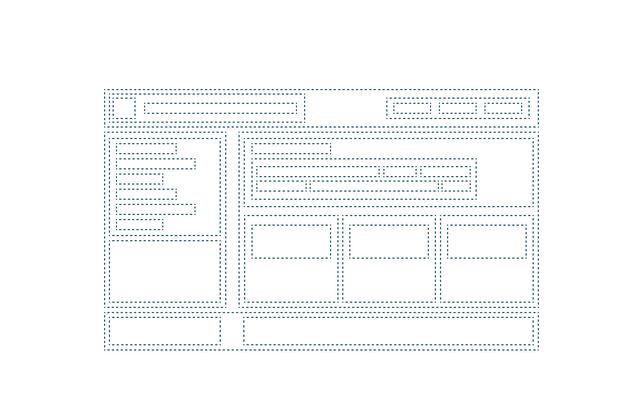
- Start with all these nested boxes
- Assume they are un-styled boxed
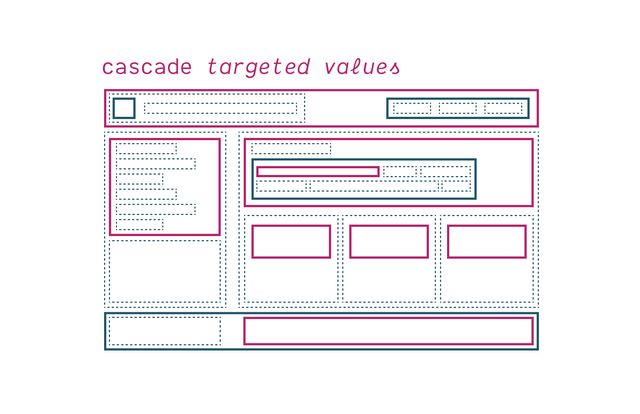
- Cascade goes first
- Explicit selectors & declarations
- Styles attached to individual elements
- Not everything gets style…
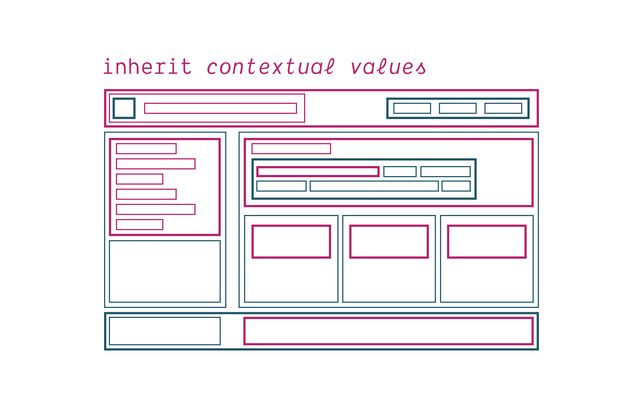
- So after the cascade is complete,
- And only when values are missing,
- Then we can apply inheritance
- Each (un-styled) box looking at it’s parent
- Values can inherit from very high up, the root of the document
- All the way in to an element nested deeply
- But to get there, properties have to inherit one nested element at a time
Inheritance Requires Lineage
- Without any cascaded values breaking that lineage
- You don’t inherit a trait from your grandparents,
- Unless your parents inherited that trait from their parents
- So we can always look at the computed value of the direct parent
- To find the value that inherits
Cascade Takes Priority
- We could say the cascade takes priority over inheritance
- In the same way origins and layers take priority over specificity
- Because the cascade goes first
- So inheritance only fills in what the cascade leaves open
- And values higher up can’t inherit through a cascaded value
- That context is lost and a new context is established
demo:
- Here the color inherits fine on everything, from the root
- But the font (even though it’s important) can’t inherit
- Wherever it is set by the cascade (blockquote, and code)
[demo]:
- cascaded declarations first
- (our element is the subject)
- (sorted by cascade priority)
- inherited declarations
- (our element is a descendant)
- (sorted by inheritance proximity)
- together: all the relevant declarations
- and which one applies!
- computed… still missing values for most props
Custom properties Can Carry Context
- So now we have properties
- That can capture the context in one location,
- And carry that context silently to descendants
- Until it’s needed
- Let’s look at a property that doesn’t inherit
- Like the
background - We can either be explicit to target with nested selectors
- Or we can pass the value through a variable!
Inheritance Rewards Proximity
- Like scope, inheritance rewards proximity
- When we nest, the closer context is what inherits
We can Inherit Across Generations
- We can also use custom properties
- To carry some context past intervening cascade values
- We can use this to revert to context higher up
Most properties Don’t Inherit
Generally… Typography Inherits
(including text colors)
Generally… Layouts Do Not Inherit
(including anything box-related)
Generally…
Un-styled Inline Boxes (spans)
Should Not Impact Layout
If I added a
spanin the middle of this paragraph, what styles would I expect to apply automatically inside thespanso that the span doesn’t change anything?
— Internal Monologue
- So we can ask ourselves
- If I inserted a span in the middle of this paragraph
- What styles would need to inherit
- So that the span doesn’t look different?
[demo]:
- Try
all:initialon the span - Try inheriting different properties
/* 😭 Nooooooo */
html { box-sizing: border-box; }
* { box-sizing: inherit; }
/* 🥳 Much better */
* { box-sizing: border-box; }- This is one reason I recommend the simplest box-sizing reset
- We shouldn’t be inheriting layout!
- Especially not as a default!
No inheritance? Use Initial Value
- Spec here is brief (see next slide)…
Each property has an initial value, defined in the property’s definition table.
— Cascade & Inheritance, § 7.1. Initial Values
[Demo lookup]:
- pick a property (display?)
- Look it up on MDN
- Check ‘formal definition’
- (shows inherited, and initial)
- Link to spec
- (same)
If the property is not an inherited property, and the cascade does not result in a value, then the specified value of the property is its initial value.
— Cascade & Inheritance, § 7.1. Initial Values
Initial Value Of A Custom Property?
html {
font-size: var(--i-never-specified-a-value);
}- What happens if we access a property
- That we never defined?
Guaranteed Invalid Value
like Undefined in JS
- All custom properties get the same initial value by default
- We call it ‘the guaranteed invalid value’
- No syntax for it, yet (I think we should add one)
- It’s only used in custom properties
- And this will surprise you…
- it’s guaranteed to be invalid on every built-in property
Properties using var() become…
Invalid At Computed Value Time
_unset_- If it ends up on a property,
- Invalid at computed value time
- Since it’s guaranteed, we know earlier in the process
- Not early enough discard before the cascade…
- We have to finish the cascade and inheritance
- We’ll come back to this idea
- When we talk about progressive enhancement
--my-variable: initial;
color: var(--my-variable, CanvasText);- But at that point when we are about replace our var function
- with a value we now know is invalid
- We can use a fallback instead
var(--my-color, teal)- The fallback comes after the name and a comma
/* fallback: 'Georgia, Palatino, serif' */
var(--my-font, Georgia, Palatino, serif)- Everything after that first comma is the fallback value
- Even if it contains more commas
- That way we can fallback to list values
var(--btn-color, var(--action, teal))- We can also fallback to other variables
- And those variables can have a fallback
- So we can create chains of fallback options
- By nesting var functions
A fallback, but… Not For Invalid Declarations
- This is not validation that the value is allowed on the property
- We only get the fallback
- If our custom property has no value at all
- Or is using the initial guaranteed invalid value
Warning Not for Legacy Support
- So it also doesn’t work for legacy support fallbacks
- Here’s a demo if you want to dig into the nuance
- We’ll look at it in more detail
- When we talk about progressive enhancement
We’ve Done It!* 🥳 Exactly One Specified Value
Either from…
- The Cascade (declarations)
- Inheritance (parent)
- Initial Value (spec)
We’ve Done It!* (* Almost)
- Ok, we’ve almost done it
- Still need to deal with…
explicit defaulting… “Global Keywords”
all shorthand- Explicit defaults
- These are the global keywords in CSS
- Which are allowed on every property
- including the
allshorthand property
Explicit Defaults…
initialinheritunset(inheritorinitial)revert(previous cascade origin)revert-layer(previous cascade layer)
- In fact, these are the only values allowed on
all - Since they are the only values allowed everywhere
initial & inherit
choose your default, explicitly
- Rarely use these
- Only if you are very sure it’s what you want
unset
whichever default is appropriate
- Prefer
unsetinstead - To get either the
initialorinherited value - Depending on the property
body { margin: unset; }- This is a great option for CSS resets
- When you really want a clean slate.
- Just ‘pretend no one ever defined this property,’
- ‘and see what happens’

- But this still has the problem
- Of mostly returning the
initialvalue, - Like
display:inline - When it’s more common that we would want…
revert
defer to previous origin
- Is the browser default styles
- Revert will unset only the author styles
- But keep browser defaults in place
- ‘Pretend We didn’t define this, and see what happens’
- But even this can be more than we want
- Ideally, we could return to our own defaults!
- Not only that, but
revert
Also… Reverts Hints & Shadow Styles
- Also eliminates presentational hints
- This is the situation where they act like part of the author origin
- And shadow DOM styles
- That’s still pretty destructive if we’re not sure about it
- But we can solve all these issues by using…
revert-layer
defer to previous layer (or previous origin)
revert-layer- This is the most chill of the explicit defaults
- It will only unset our current cascade layer
- Leaving everything else in place
- So we can fall back to a lower layer,
- or shadow DOM, or presentational hints, or browser defaults
- or even the initial or inherited value
- If a property isn’t defined in a lower layer
- We usually use
unsetor one of therevertvalues
Global keywords… Resolve on Custom Properties
- Global keywords on all properties
- Including custom properties
html {
--color: teal;
--color: initial;
background: black;
background: var(--color, red);
}- No way to pass keywords along as values
- Importance also applies to the variable!
(ok, now) We’ve Done It! 🥳 Exactly One Specified Value
- The Cascade (declarations)
- Inheritance (parent)
- Initial Value (spec)
- Explicit Defaults (keywords)
Filtering (0+declared values)Cascading (0|1cascaded value)Defaulting (1specified value)- Resolving (
1computed value) - Formatting (
1used value) - Constraining (
1actual value)
- The next step of value resolution
- Is to get the ‘computed’ value
- making any relative values absolute
p {
color: hotPink; /* rgb(255, 105, 180) */
border-color: currentColor; /* rgb(255, 105, 180) ? */
font-size: 1.2em; /* 19.2px ? */
/* these require formatting */
width: 80%; /* still 80% */
height: auto; /* still auto */
}Computed Values Inherit
currentColor!)- Computed values inherit
- Which might sound backwards, since we already handled inheritance!
- But this whole process happens outside-in
- The parent has to resolve, so children can inherit,
- And then they have to resolve before the next generation can inherit
I Am Not A Lawyer
and this is not legal advice
- This is all starting to sound like genetics
- Or maybe estate law?
- I am not a biologist or a lawyer,
- So don’t take this as legal advice.
currentColor
Inherits as Keyword
It should re-calculate when the color changes!
- There are exceptions
- CurrentColor inherits as a keyword, which is handy
- It will re-calculate as the color changes
Custom Properties… Remain As Specified
p {
--my-size: 1.5lh; /* 1.5em */
--my-color: hotPink; /* hotPink */
}- Value hasn’t been parsed/validated
- Not clear yet what type this is
- Can’t make it absolute without a type
- Or, for relative units like
lhknowing what line to measure
Custom Properties… Substitute, Then Inherit
- Custom properties don’t resolve before inheriting
- But they do substitute before inheriting
- Not
html {
--my-size: 1.5lh; /* 1.5lh */
--calc: calc(var(--my-size) * 2);
}
p {
/* --calc: calc(1.5lh * 2) */
/* not calc(var(--my-size) * 2) */
}
Built-in properties…
Validate & Compute var()
p {
/* inherited calc(1.5lh * 2) */
color: var(--calc); /* unset */
min-height: var(--calc); /* 3lh */
}demo:
- see ‘computed’ panel
- custom properties aren’t resolving?
- only one! let’s look into that…
![Image of animated Pinochio, no longer a puppet, saying I'm a real [property]](/img/OEeDJz1FtS-426.jpeg)
- We’ve talked about defaults
- But some custom properties dream of becoming more…
@property --brand-color {
syntax: "<color>";
inherits: true;
initial-value: hotPink;
}- And we can use to the at-property rule
- To define more about them,
- The stuff that usually gets defined in a spec
- For built-in properties
- The syntax, initial value, and if it should inherit or not
Can I use… @property
- This is finally, recently, supported everywhere!
All three Descriptors Required
syntax, inherits, and (usually) initial
inherits
true or false
/* replace 'initial' with any default value */
* { --this-property: initial; }- Remember, if we don’t register the property
- Inheritance is true by default
- We can override that by defaulting it explicitly everywhere
- That doesn’t turn off inheritance,
- Just ensures we never get around to inheriting
- Because there’s always a declared value
syntax…
Supported Names
Or "*" for ‘universal syntax’
Does Not Fix Invalid At Computed Value Time
- Definitions are still not
- available at parse time (could be redefined)
- or stable enough to rely on (if new styles load)
Does Give Us Computed Values
(depending on syntax)
demo:
- remove and re-add registration
- inspect computed values
- change to universal syntax (doesn’t compute)
- change to color syntax (invalid)
Also… Allows Transitions & Animations
No Type Coercion
.yes-number-to-length {
--number: 1;
--length: calc( var(--number) * 1em);
/* not `var(--number)em` */
}calc().no-length-to-number {
--length: 1em;
--number: calc( var(--length) / 1em );
}- There’s a workaround by Jane Ori
- Using trigonometry functions
- If you want to play with it
initial-value…
Must be Absolute
(when the syntax is not *)
Initial ~= Spec
Root/* ~= Browser Default
initialvalues equivalent to spec initial- Not right for every situation,
- But a good fallback
- Declarations on root/* better for dynamic tokens
Final Steps Used & Actual Values
- All properties that apply
- But some props might not apply
- Because CSS properties are modal!
- (e.g.
flex: 1on a non-flex item) - (or
display:inlineany time it’s not in flow) - Usually the same as ‘computed’ value
html {
color-scheme: dark light;
/* ~ used: dark; */
}div {
width: 80%;
/* ~ used: 1049.6px; */
/* ~ actual: 1050px; */
}🥳 Values Resolved
- That’s it,
- the entire ‘value resolution’ process
Intermission
- Any questions on that,
- before we get into
- more variable use-cases?
Custom properties can Store Global Tokens
:root { --btn-color: maroon; }html/:root, then inherit)- These tokens will inherit everywhere
:root { --btn-color: maroon; }
/* html { --btn-color: maroon; } */html or :root- Either root or html is fine
- In any html document, select the same thing
- Maybe you find it more clear?
- Mostly just increases specificity
- (Element type to Pseudo-Class)
Any Document Root
Like <svg> or <xml> or <html>
- It’s true!
- But is it actually what you want?
demo:
- just an svg on it’s own
- root styles apply to the svg element
demo:
- same svg in a page
- (styles commented out)
- html styles targeting the root & svg…
- what happens when we uncomment?
I dunno… Proceed With Caution?
- It’s not bad to put vars on root
- But careful about using root
- In nested contexts
- Not every root, only the (outermost) root
* { --btn-color: hotPink; }- Another global approach
- Select everything
- Rely on cascade, not inheritance
But not all Tokens Are Global
- Not all design tokens need to be global
button { --btn-color: maroon; }- Can also define locally
- Specific to a component
button[type='submit'] {
--btn-type: seaGreen;
}
[aria-pressed=true] {
--btn-state: rebeccaPurple;
}- Even variations of a component
[data-grid] > * { --grid-area: main; }- We can combine these approaches
- Define on everything in a certain context
Define Nowhere???
- You don’t need to define anywhere to start
- Sometimes useful to have ‘open’ (undefined) vars…
button {
background: var(--btn-context, maroon);
}- Creating a button component
- We can put the default value in a fallback
- And leave the variable open for inheritance
- Then later, we can fill it in…
main { --btn-context: mediumVioletRed; }
[type='submit'] { --btn-context: steelBlue; }
button:focus { --btn-context: seaGreen; }- Override based on specific locations
- Or based on different variations
- In the component or interaction state
Custom properties Manage Dynamic Changes
- Great for dynamic changes, like…
<button style="--btn-color: red;">
You're not the boss of me
</button>/* --btn-color is not being used */
button {
background: seaGreen;
color: white;
}Combine with… Attribute Selectors
[attr]➡ Presence (even if empty)[attr="..."]➡ Exact match[attr*="..."]➡ Any match[attr~="..."]➡ Space-delimited (like classes)[attr|="..."]➡ Hyphen-delimited[attr^="..."]➡ Starts with…[attr$="..."]➡ Ends with…[attr="..."i|s]➡ Case sensitivity
<!-- Element-attached/inline -->
<div style="--ease: var(--in-out-back);">[style*='--ease'] {
--in-quad: cubic-bezier(0.55, 0.085, 0.68, 0.53);
--out-quad: cubic-bezier(0.25, 0.46, 0.45, 0.94);
--in-out-back: cubic-bezier(0.68, -0.55, 0.265, 1.55);
}JavaScript Interactions
html {
@media (prefers-color-scheme: dark) {
--os-mode: -1;
}
@media (prefers-color-scheme: light) {
--os-mode: 1;
}
}[data-colors='light'] {
--html-mode: 1;
}
[data-colors='dark'] {
--html-mode: -1;
}[data-colors] {
--mode: var(
--html-mode, var(
--user-mode, var(
--os-mode, 1
)
)
);
}--user-mode set via JS- I’ve been updating that to use oklch colors
- With color-scheme and the light-dark function
- But many of those features are still too new
- To rely on without a thoughtful fallback
CSS Animation
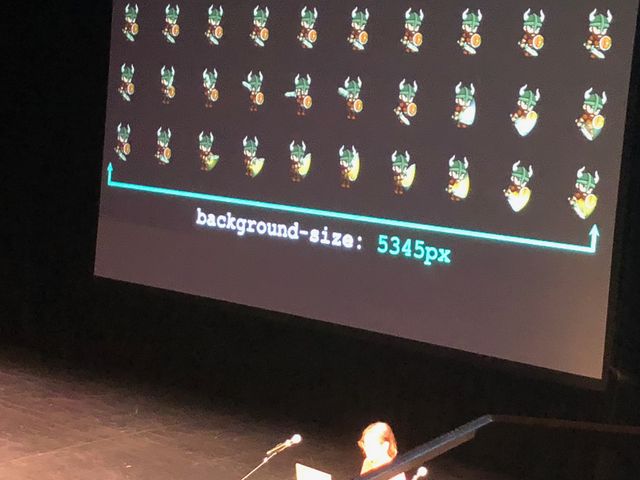
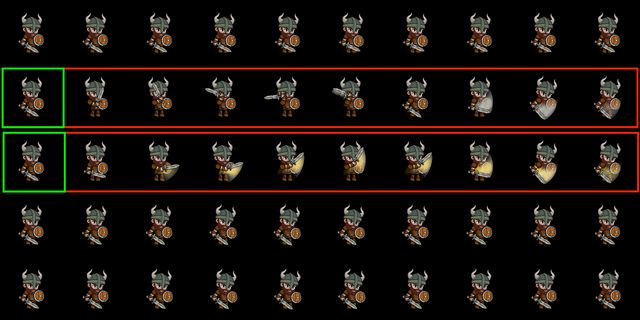
<section
class="sprite-demo"
:style="{
'--src': show.sprite.src,
'--columns': show.sprite.columns,
'--rows': show.sprite.rows,
}">...</section><div
v-for="action in show.actions"
:key="action.name"
:data-action="action.name"
:style="{
'--row': action.row,
}"
/>Custom Properties Are Not Just Variables
(as we’ve known them)